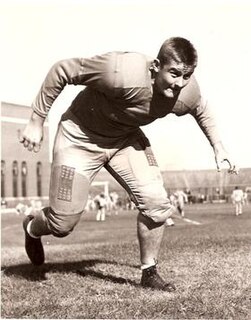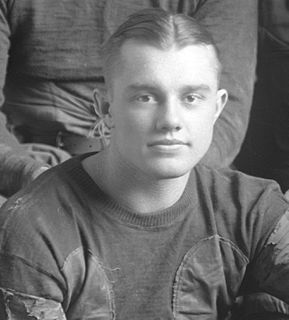For the famous art forger of the same name, see Tom Keating.For the priest and author of the same name see Thomas Keating.

Frank Clayton "Clayt" Tonnemaker was an American football player who played center and linebacker for the Green Bay Packers from 1950 to 1954. Tonnemaker was an All-American at the University of Minnesota, where he played center linebacker. In 1980, he was inducted into the College Football Hall of Fame.

Howard Pierce "Cub" Buck was an American football player and college coach. He played as a tackle at the University of Wisconsin–Madison, captaining the team and earning consensus All-American honors in 1915. Buck then played professionally for 10 seasons in the National Football League (NFL) with the Canton Bulldogs (1916–1920) and Green Bay Packers (1921–1925). Buck served as the head football coach at Carleton College from 1917 to 1919, at Lawrence College in 1923, and as the first head coach at the University of Miami from 1926 to 1928. He was inducted into the Wisconsin State Athletic Hall of Fame in 1956, the Green Bay Packers Hall of Fame in 1977, and the University of Wisconsin Athletic Department Hall of Fame in 1991.

Frederick Lee "Ted" Petoskey was a three-sport athlete at the University of Michigan, a Major League Baseball player, a collegiate coach in three sports and an athletic director.

Irwin Charles "Utz" Uteritz was an American athlete and coach. He played American football and baseball for the University of Michigan from 1921 to 1923. At 140 pounds, he was one of the lightest quarterbacks ever to start for a major college program. Despite his size, Michigan football coach Fielding H. Yost called him "the best field general I ever had." Uteritz led Michigan to back-to-back undefeated seasons and a national championship in 1923. He also played three years of baseball for Michigan at second base and shortstop, hit above .300 and was elected as captain of the 1923 baseball team. Uteritz later served as a football and baseball coach at Northwestern University (1924–1925), the University of Wisconsin (1925–1935), the University of California (1935–1947), and Washington University in St. Louis (1947–1963).

Walter Francis "Jack" Crangle was an American football fullback. He played college football for the University of Illinois and was selected as an All-American in 1920 and 1921. He was a member of Illinois' Big Ten Conference championship teams in 1919 and 1920. He played one season of professional football for the Chicago Cardinals of the National Football League. He was selected as a second-team All-NFL player by Collyers Eye Magazine in 1923. He also played minor league baseball in 1924 for Elgin in the Chicago League. Crangle later became a football and basketball coach at St. Viator College, head baseball coach and assistant football coach under Gwinn Henry at the University of Missouri and assistant football coach at St. Louis University. In his later years, he worked for the Aluminum Company of America and operated a filling station north of Columbia, Missouri. Crangle died at his home in Independence, Missouri at age 45 in 1944. Following Crangle's death in 1944, Jack Ryan of the Chicago Daily News wrote that Crangle "rates high among the many good backs Bob Zuppke developed at the state university." Howard Millard of the Decatur Review wrote: "It doesn't seem possible that Jack Crangle, the big, easy going, likeable fellow, probably the greatest fullback in all Illinois University history, is dead." Crangle was survived by his widow, Marjorie.
The 1940 Wisconsin Badgers football team was an American football team that represented the University of Wisconsin in the 1940 Big Ten Conference football season. The team compiled a 4–4 record and finished in a tie for fourth place in the Big Ten Conference. Harry Stuhldreher was in his fifth year as Wisconsin's head coach.
The 1942 Wisconsin Badgers football team was an American football team that represented the University of Wisconsin in the 1942 Big Ten Conference football season. The team compiled an 8–1–1 record, finished in second place in the Big Ten Conference, led the conference in scoring defense, and was ranked No. 3 in the final AP Poll. Harry Stuhldreher was in his seventh year as Wisconsin's head coach.
The 1921 Wisconsin Badgers football team was an American football team that represented the University of Wisconsin in the 1921 Big Ten Conference football season. The team compiled a 5–1–1 record, finished in fourth place in the Big Ten Conference, shut out four of seven opponents, and outscored all opponents by a combined total of 141 to 13. John R. Richards was in his fifth year as Wisconsin's head coach.
The 1922 Wisconsin Badgers football team was an American football team that represented the University of Wisconsin in the 1922 Big Ten Conference football season. The team compiled a 4–2–1 record, finished in fourth place in the Big Ten Conference, shut out four of seven opponents, and outscored all opponents by a combined total of 101 to 22. John R. Richards was in his sixth and final year as Wisconsin's head coach.
The 1921 All-Big Ten Conference football team consists of American football players selected to the All-Big Ten Conference teams chosen by various selectors for the 1921 Big Ten Conference football season.
The 1921 All-Western college football team consists of American football players selected to the All-Western teams chosen by various selectors for the 1921 college football season.
Lloyd A. "Butch" Pixley was an American football player. A native of Columbus, Ohio, he played college football for the Ohio State Buckeyes at the guard position in 1918, 1919, 1921, and 1922.
The 1923 Big Ten Conference football season was the 28th season of college football played by the member schools of the Big Ten Conference and was a part of the 1923 college football season.
The 1942 Big Ten Conference football season was the 47th season of college football played by the member schools of the Big Ten Conference and was a part of the 1942 college football season.
The 1961 Big Ten Conference football season was the 66th season of college football played by the member schools of the Big Ten Conference and was a part of the 1961 college football season.
The 1960 Big Ten Conference football season was the 65th season of college football played by the member schools of the Big Ten Conference and was a part of the 1960 college football season.
The 1921 Big Ten Conference football season was the 26th season of college football played by the member schools of the Big Ten Conference and was a part of the 1921 college football season.
The 1920 Big Ten Conference football season was the 25th season of college football played by the member schools of the Big Ten Conference and was a part of the 1920 college football season.
The 1984 Big Ten Conference football season was the 89th season of college football played by the member schools of the Big Ten Conference and was a part of the 1984 NCAA Division I-A football season.







